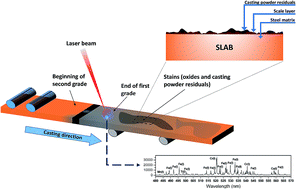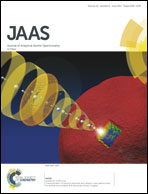At-line monitoring of continuous casting sequences of steel using discriminant function analysis and dual-pulse laser-induced breakdown spectroscopy
Abstract
Among the several controlling routines utilized in the steelmaking process, analytical operations during continuous casting are especially demanding due to the extreme environment of steel plants and the crude conditions of the steel surface at the exit of the casting system. This report presents how dual-pulse laser-induced breakdown spectroscopy (LIBS) can be used for the real-time monitoring of continuous casting sequences in a steel plant and the operations needed for detecting the separation between grades of close chemical compositions. Diverse dual-pulse laser conditions have been tested in order to improve the LIBS system performance. Apart from the scale layer formed by the oxidation of steel by the surrounding air, the presence of residues of mould powder on the steel surface tends to complicate the LIBS analysis as elements present in the powder such as manganese interfere with the steel components. LIBS data processing by discriminant function analysis has been demonstrated to be beneficial for the identification of steel transitions. Changes in steel composition as low as 0.20 percentage points Cr in a stainless steel sample containing above 17% of this element are detected by corresponding changes in Wilks' lambda values from 1.0 to 0.75 during the transition. Changes in the concentration of nickel are of minor relevance as its concentration on the steel surface at the time of continuous casting is depleted. For steel concentrations differing to a larger extent, differentiation of steel grades is straight, involving changes in Wilks' lambda values from 1 to below 0.1.

- This article is part of the themed collection: JAAS Recent HOT articles


 Please wait while we load your content...
Please wait while we load your content...